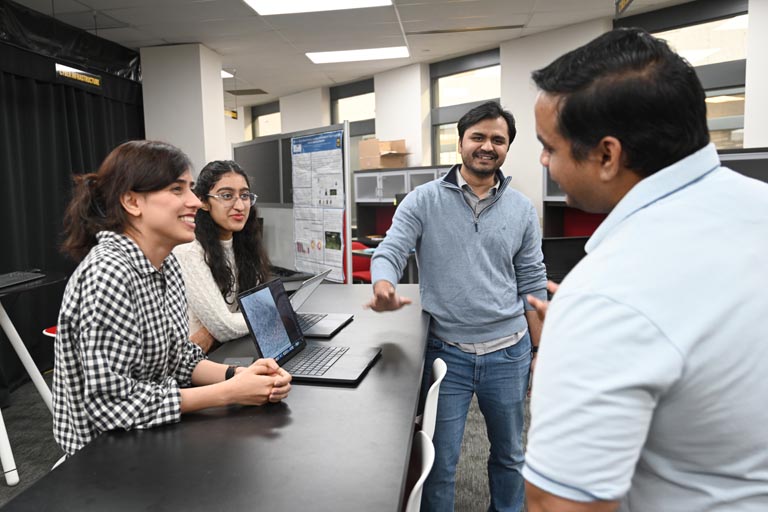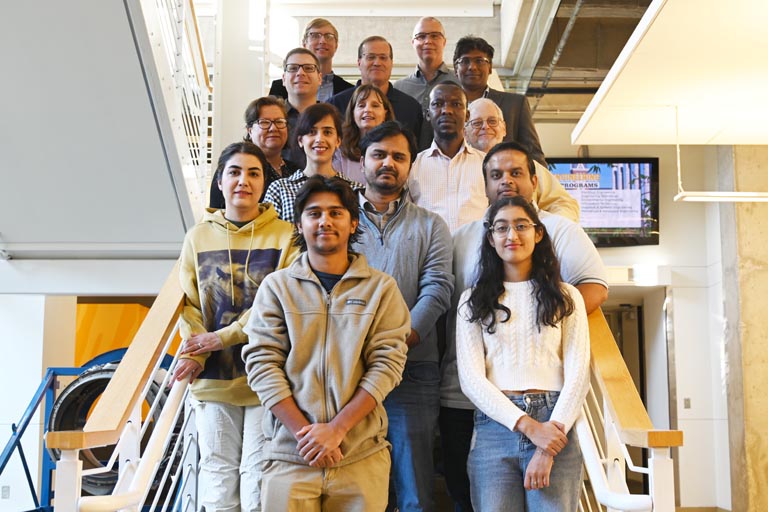November 12, 2024
Mizzou Engineers are partnering with Arizona State University, Brewer Science and the U.S. Army Corps of Engineers Engineer Research and Development Center (ERDC), to increase the efficiency of materials development by using artificial intelligence (AI) and machine learning (ML) to model and test new materials. Mizzou’s research is supported by a $1.87 million grant, sponsored by Arizona State University.
![The multidisciplinary team consists of faculty from Mechanical Engineering (Matt Maschmann), Chemical and Biomedical Engineering (Matthias Young, Sheila Grant and David Grant) and Electrical Engineering and Computer Science (Jianlin Cheng [not pictured], James Keller, Filiz Bunyak and Prasad Calyam).](https://engineering.missouri.edu/wp-content/uploads/2024/11/DSC_4763.jpg)
As part of a flagship and land grant institution, Mizzou Engineering is a hub for foundational research. Now, Mizzou Engineers Sheila Grant, David Grant and Prasad Calyam are leading a team of interdisciplinary and interinstitutional researchers to make the development of new materials much faster.
The project, in partnership with Arizona State University, Brewer Science and the U.S. Army Corps of Engineers Engineer Research and Development Center (ERDC), aims to increase the efficiency of materials development by using artificial intelligence (AI) and machine learning (ML) to model and test new materials.
“The development of new materials can take a long time because we have to experimentally test hundreds of ‘recipes’ in order to obtain materials with the desired properties,” Sheila Grant, professor of chemical and biomedical engineering and Executive Director of Mizzou TecHub, said. “Using large language models (LLMs), the same technology as ChatGPT, we can have a computer create those combinations, test the interactions and deliver expected results in a fraction of the time.”
From there, she says, researchers will take the material recipes that look most promising and test them in the lab using experiments with scientific instruments for microscopy and spectroscopic ellipsometry. The time saved by LLMs doing the first steps will make the experiment process exponentially faster, giving engineers and scientists more time to develop workable materials that solve problems.
This process will apply to all materials development. Initially, the project aimed to create semiconductors during shortages in the early 2020s. Now, the team is also looking into growing carbon nanotubes and developing electronics without using precious natural resources.
“In my mind, the innovative factor about this work is that it could apply to many materials; researchers can feed their own needed properties into the ML,” David Grant, research engineer and Director of Mizzou TecHub, said. “If we could develop a repository of different properties of materials, then someone can look for the specific property they need in the ML and use it in whatever new material they’re creating.”

Combining disciplines to push the boundaries of what’s possible
More than 30 Mizzou faculty, post-docs, graduate students and undergraduates are part of the project, representing the departments of chemical and biomedical engineering, electrical engineering and computer science, and mechanical and aerospace engineering. The research is being supported by a $1.87 million grant, sponsored by Arizona State University.
“The most exciting part of this project is the interdisciplinary collaborations that are being enabled,” Prasad Calyam, Curators’ Distinguished Professor of electrical engineering and computer science, said. “We have material scientists working closely with high-performance computing and data science experts. Together, we are creating new knowledge on how emerging AI advances can create automated, and even autonomous, material discovery processes in an effective as well as explainable, responsible manner,”
Sheila Grant says that the work they’re doing is unique because of the type of partnership that’s powering this project as well as the far-reaching applications of this novel materials development method.
“It’s not common to have a project with partners in academia, industry and the government all working toward the same goal like this,” she said. “Our partners have been essential to making this research progress, and we’re finding new ways of working together across disciplines. Computer scientists are teaching materialists how to do what they do, and vice versa. The types of collaborations we’ve seen have been inspiring.”
The team hopes to create a consortium out of this project to expand its reach and make it more accessible to other researchers. In the meantime, the team is working closely together to develop the technology required.
“In the project meetings, we regularly have students teaching each other and the faculty new ideas from their specific domain perspectives pertaining to material science, polymer science and computer science,” Calyam said.
Revolutionizing industry

All three researchers emphasized that the project has also been a great experience for the students working on it.
“Whether they’re undergraduates or grad students, this project has been opening doors,” David Grant said. “Some students are planning to continue into academic research. Others are planning to go into industry. And those who are going into industry are taking what they learn here with them, so they’re able to use the ideas we’re discovering to help others accelerate their materials development to move technology faster there as well.”
Ultimately, what excites them about the project is how it can change the manufacturing landscape as we know it.
“With materials, you never know what you’re going to discover,” Sheila Grant said. “Success of this project could eventually lead to new discoveries such as a new type of polymer to revolutionize the chip industry or increase energy efficiency. The possibilities can be endless.”
Conduct research that pushes the boundaries of discovery. Learn more!